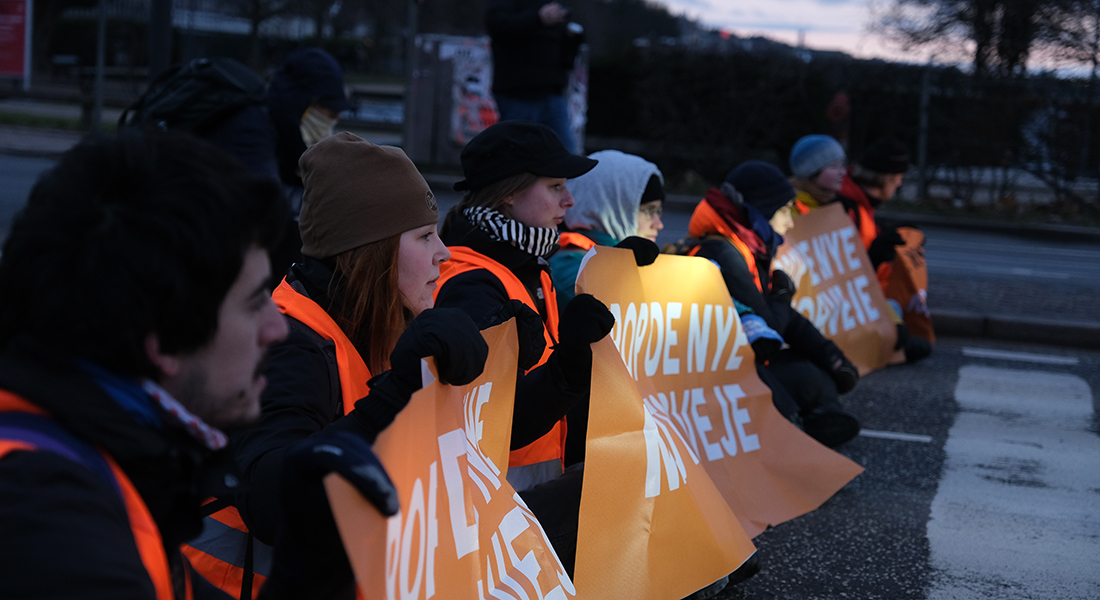The Paradox of Climate Protest
Disruptive protest actions are among the tools often used by climate activists. New research from the University of Copenhagen shows that these types of actions have the intended effect: they raise public awareness of climate change. However, they also carry the risk of backlash.

Climate activism takes many forms, but one of the most visible is so-called disruptive protests. These protests are characterized by interruptions to everyday life or specific cultural events.
Examples of disruptive protests include blocking construction works, throwing paint at a painting or interrupting a sporting event. These types of actions have gotten significant media coverage in recent years.
According to Assistant Professor Clara Vandeweerdt, it is no wonder that climate activists often choose disruptive protest as a form of communication. It works, research shows.
Greater Awareness
Clara Vandeweerdt is an assistant professor at the Department of Political Science. Her primary area of focus is Climate and Public Opinion.
Her latest study, “The Activist’s Trade-off: Climate Disruption Buys Salience at a Cost,” shows how non-violent disruptive protest actions lead to increased awareness of climate change as a societal issue—but also presents a paradox:
“The paradox is that a disruptive protest can indeed attract attention and elevate an issue on the political agenda. But we also observe a small backlash effect,” she says.
The backlash effect relates to the specific policy change demanded by the activists.
“One example I used in my research involves activists blocking a road to protest the construction of new motorways in Denmark. But we found that people who saw the protest were actually more likely to support new motorways,” says Clara Vandeweerdt.
Her research shows that people generally rank climate change as a more important societal issue after seeing media coverage of disruptive protests, but some are also less inclined to support the specific political measures promoted by the activists. At the same time, people’s broader concern about climate change and their willingness to act on it stays the same.
Method and Results
Clara Vandeweerdt’s research is based on two concrete examples of media coverage of disruptive climate protests: one was a motorway blockade in Denmark, and the other was the interruption of a televised snooker match in the UK.
“It’s a classic experimental setup, where all participants were divided into two groups. One group was simply asked an open question about what they thought were the most important political issues right now, as well as more specific questions about climate change and climate policy,” explains Clara Vandeweerdt.
“The other group answered the same questions, but first they read a news article about a disruptive climate protest,” she says.
The study shows that participants in the second group were 10 to 19 percent more likely to name climate change as a major societal issue compared to the control group. However, the same participants expressed more negative attitudes toward the specific climate policy demands made by the activists.
Is It Worth It?
The big question is whether, given this knowledge, it is worthwhile to use disruptive protest actions as a tool for climate activism.
“When activists decide whether to carry out a disruptive protest, a peaceful protest, or no protest at all, they need to consider this trade-off between gaining attention and risking backlash,” says Clara Vandeweerdt.
She emphasizes, however, that the effect on awareness is significantly greater than the backlash effect.
“But it would be interesting to find out whether there are ways to conduct protest actions that raise awareness without triggering backlash. Of course, one can engage in non-disruptive activism. That doesn’t cause backlash, but we also see that it barely gets any attention. Even if large numbers of people participate in a peaceful protest march, it’s difficult to get media coverage,” she says.
She also imagines that the research could be of interest to public authorities, governments, and courts.
“They have to respond to protest actions and try to handle disruptive activism appropriately. It’s helpful if they understand what effect activism actually has on society,” says Clara Vandeweerdt.
“The Activist’s Trade-off: Climate Disruption Buys Salience at a Cost” is peer-reviewed and published in the journal Political Behavior.
Contact
Clara Johan E Vandeweerdt
Assistant Professor
Department of Political Science
M: +45 21861549
E-mail: clara.vandeweerdt@ifs.ku.dk
Simon Thinggaard Hjortkjær
Press Advisor
UCPH Communication
M: +45 93 56 53 20
E-mail: sihj@adm.ku.dk
